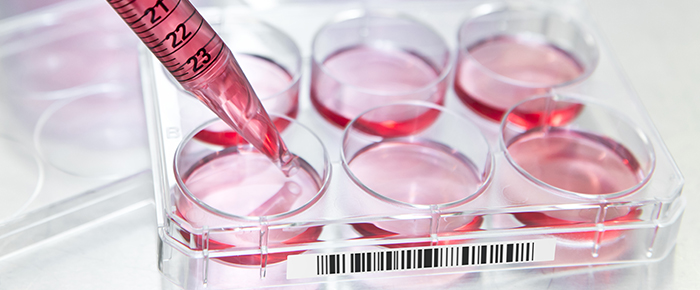 Almost all labs in the biomedical research industry depend on cell culture to some degree. Many culture mammalian cells to understand molecular pathways, screen for new disease targets, and assess drug toxicity. Others culture microorganisms to use as model organisms or to figure out ways to combat pathogenic strains. In all cases, labeling for cell culture requires that flasks and dishes be appropriately identified and that media bottles be labeled accurately.
Almost all labs in the biomedical research industry depend on cell culture to some degree. Many culture mammalian cells to understand molecular pathways, screen for new disease targets, and assess drug toxicity. Others culture microorganisms to use as model organisms or to figure out ways to combat pathogenic strains. In all cases, labeling for cell culture requires that flasks and dishes be appropriately identified and that media bottles be labeled accurately.
Culturing cells & experimentation
Most cells are grown in flasks or plates, with the container’s shape and size depending on cell type and the number of cells required. Cells are stored in incubators set at specific temperatures and, once taken out to be treated, passaged, or examined, need to rest in a sterile location. For mammalian cell culture, this area is the biosafety cabinet, a large laminar-flow hood that prevents bacteria and other contaminants from accumulating. Everything that enters the biosafety cabinet must be disinfected beforehand, either with 70% ethanol solution or, for IVF labs, something that emits fewer volatile organic compounds (VOCs), such as Oosafe®. Because of this, all labels and printouts used for cell culture should withstand the disinfectant of choice in your lab. Inkjet and thermal-transfer printers provide resistance against most chemicals used to sterilize consumables, including alcohols. Alternatively, an alcohol-resistant marker can also be used to identify flasks and plates.
When labeling in the biosafety cabinet, labels, just like everything else, should be sterilized before applying them to culture flasks and plates. There are a few ways you can do this; however, most methods, including autoclaving the labels or applying disinfectant to them before placing them into the cabinet, risk ruining the label liner. The best way to prepare your labels is by printing them ahead of time, setting them inside the biosafety cabinet, and allowing the cabinet’s UV light to sterilize them for 15 to 30 minutes. They can then be applied to all cell culture containers.
When labeling flasks for mammalian cell culture, one label, placed either on the top or the side of the flask, will do. However, for cell culture plates, both the side of the lid and the bottom of the dish should be labeled with the same information. This ensures that the lid won’t become mixed up with other samples, potentially cross-contaminating them. For labels affixed to the bottom of the plate, transparent labels should be applied; if 1D barcodes are to be used, the barcodes should be printed in reverse so that the plate can be scanned without turning it upside down or moving it around.
For bacteria, fungi, and other microorganisms, labeling is much easier, as these types of cells only require a bench with a Bunsen burner to keep the area sterile. The labels should still be disinfectant-resistant, but no prior sterilization is needed before applying them to culture flasks and plates. Though the plates used in microbiology are nearly identical to those used for mammalian culture, the labels needed to identify them are not. Unlike mammalian plates, microbiology plates may need to be stored in cold temperatures, such as the lab refrigerator, to preserve colonies of the organism on agar for later use. Here, deep-freeze labels that resist lab fridges and freezers are ideal. They should still be labeled on the side of the lid as well as the bottom, though.
Freezing cells for storage & shipping
Whether you’re working with mammalian cultures or microorganisms, preserving the cells long-term requires a cryoprotectant and storage in liquid nitrogen or a -135°C freezer. Using any means other than cryogenic labels to identify your vials risks the label failing, which could result in unidentified cell lines and strains. Cryogenic labels resist both the extreme temperatures that come with storage in liquid nitrogen (-196°C) and provide resistance against common cryoprotectants, like dimethyl sulfoxide (DMSO) and isopropanol, which are often used to help freeze cells. Keep in mind that there are many different families of cryo labels, all of which may be useful for cell culture. If culture vials need to be relabeled, CryoSTUCK® labels that stick to previously frozen surfaces without defrosting and ruining the aliquot are an optimal choice. There are also cryo labels specially designed for metal racks and canes used to store boxes of cell vials. Simultaneously, in IVF labs, storage of eggs, sperm, and embryos requires cryo straws, which need to be identified with specialty labels that wrap around the straws and emit low levels of VOCs.
Checking for contamination
Often, contamination can be spotted relatively easily: the color of the culture media might change, or you might see a cloudy suspension of cells in a plate that’s supposed to contain only adherent cells. However, mycoplasma, a type of bacteria that lacks a cell wall, is much more challenging to spot. Because mycoplasma can affect your cells’ properties, potentially leading to skewed experimental results, it’s essential to check for contamination frequently and to ensure each new aliquot of cells you thaw isn’t contaminated. To do this, companies offer a few kinds of kits, including PCR-based ones, to assess mycoplasma presence in your cultures. For those who rely on PCR-based kits, it should come as no surprise that labeling the tops or sides of PCR tubes and microplates with a marker isn’t easy. Using dot labels for PCR tubes provides a bit more surface to write or print on, but the best option is PCR-TagTrax™, a series of adhesive-free, glove-friendly tags designed for small PCR tubes and non-skirted quantitative PCR (qPCR) plates. The primary purpose of these tags is to provide additional space for information than label dots, so you can appropriately barcode your PCR tube strips or plates. They’re also thermal-transfer printable and compatible with most thermocyclers. They can even be used as a stand to help store your tubes in the freezer.
Cell culture requires a lot of experience to master: after so many years in research, it’s still enormously difficult to get two independent cell-based experiments to work just right. Therefore, it’s crucial to avoid taking a chance on misidentifying your cells or, worse, losing their identity altogether. Using the appropriate labels will ensure you avoid these costly mix-ups. They’ll also allow you to keep track of your inventory of banked cells, especially for labs that propagate and freeze an immense number of cells.
LabTAG by GA International is a leading manufacturer of high-performance specialty labels and a supplier of identification solutions used in research and medical labs as well as healthcare institutions.




